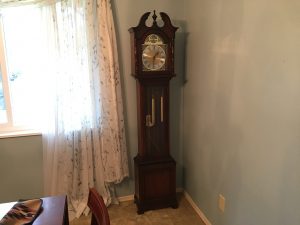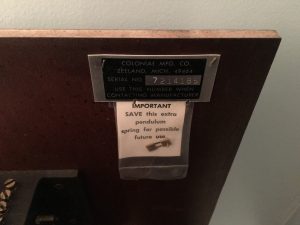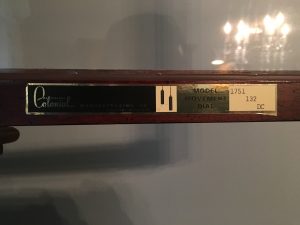I went through a phase in my youth where I was obsessed with clocks. Something about the sophistication of mechanical engineering to such an exactness so as to measure time accurately was just fascinating. Beauty can indeed be defined through such means, like the way I appreciate a fine knife for its design and metallurgy long after it’s been scratched and resharpened into what so many others view as a simple chuck of cutting steel. It’s why I went through a lockpicking phase–timeless engineering that has only been marginally improved upon. Analog perfection.
I never quite grew out of that phase.
In the Lubbock years, one of dad’s colleagues had a grandfather clock. It was bizarredly contrasted to the lime-green shag carpeting which traversed the entire house, but even that could be overlooked when in the presence of such a masterpiece. It was a dark reddish wood, perhaps mahogany, with the typical polished bronze components. Its quarter-hour chimes punctuated the evenings with delicate reminders of time’s passage without being jarring. The chimes, I would only recently discover, were the Westminster quarters.
Since then, I had always been on the lookout for such a clock to call my own, but transient residences and limited finances prohibited such an investment. Finances still do, as a true grandfather clock today runs well into the thousands. But on occasion, I would see them in antique stores and would be reminded of the fantasy. The ones in these stores were markedly smaller and cheaper than what I remembered too, and labeled with dubious claims like “It still works”, despite not actually having been wound recently, and “As-is, no returns”. Conditions such as these are why my next car will not be pre-owned.
Then a neighbor had an estate sale. Liz snapped a photo of such a clock and asked if I wanted it–for a modest $75. Turns out it was a grandmother clock–a smaller variant, and term with which I was unfamiliar. But, it had been maintained by The Village Elder, so its mechanics were guaranteed from a reliable source. I confirmed the purchase, and with the help of The Village Elder, it was waiting for me in the dining room when I got home. Whatever it’s called officially, it’s still a satisfying 6 feet, and while being of a laminated wood, looks as nice as any well-made laminated furniture. And the price couldn’t be beat.

But of course I couldn’t let it go as a simple aesthetic accent for the room. I needed to know its origin.
So I opened the clock and looked for identifying marks. I found 2:


And so the internet search began!
The metal plate revealed that the clock had been made by Colonial Manufacturing–a company based in Zeeland, MI; and a company that had apparently gone out of business in 19831.
Further digging led me to a clock specialists’ forum, which claimed that the catalogs didn’t exist in any readily-available digital form, but the metal stamps weren’t introduced until the 1970s2. This backed the claim of clocks I had seen previously in the antique stores, which were labeled as from the 70s. Also, the veneer is thick, and modern stranded board is from the early 1980s, so while not definitive, it would appear logical to conclude the type of veneer to be a direct predecessor, so again–1970s.
Is a far cry from the ominous chronographic sentinel of my memories, but it’s a very lovely timepiece nonetheless. And its chimes are the same. Liz too has distinct memories of that sound. Perhaps it will be good for the kid–to give her a sense of how fleeting time really is. Eternal time, measured in quarter hours. Tempus Fugit indeed.
–Simon
1http://www.furniturecityhistory.org/company/3447/colonial-manufacturing-co
2https://mb.nawcc.org
